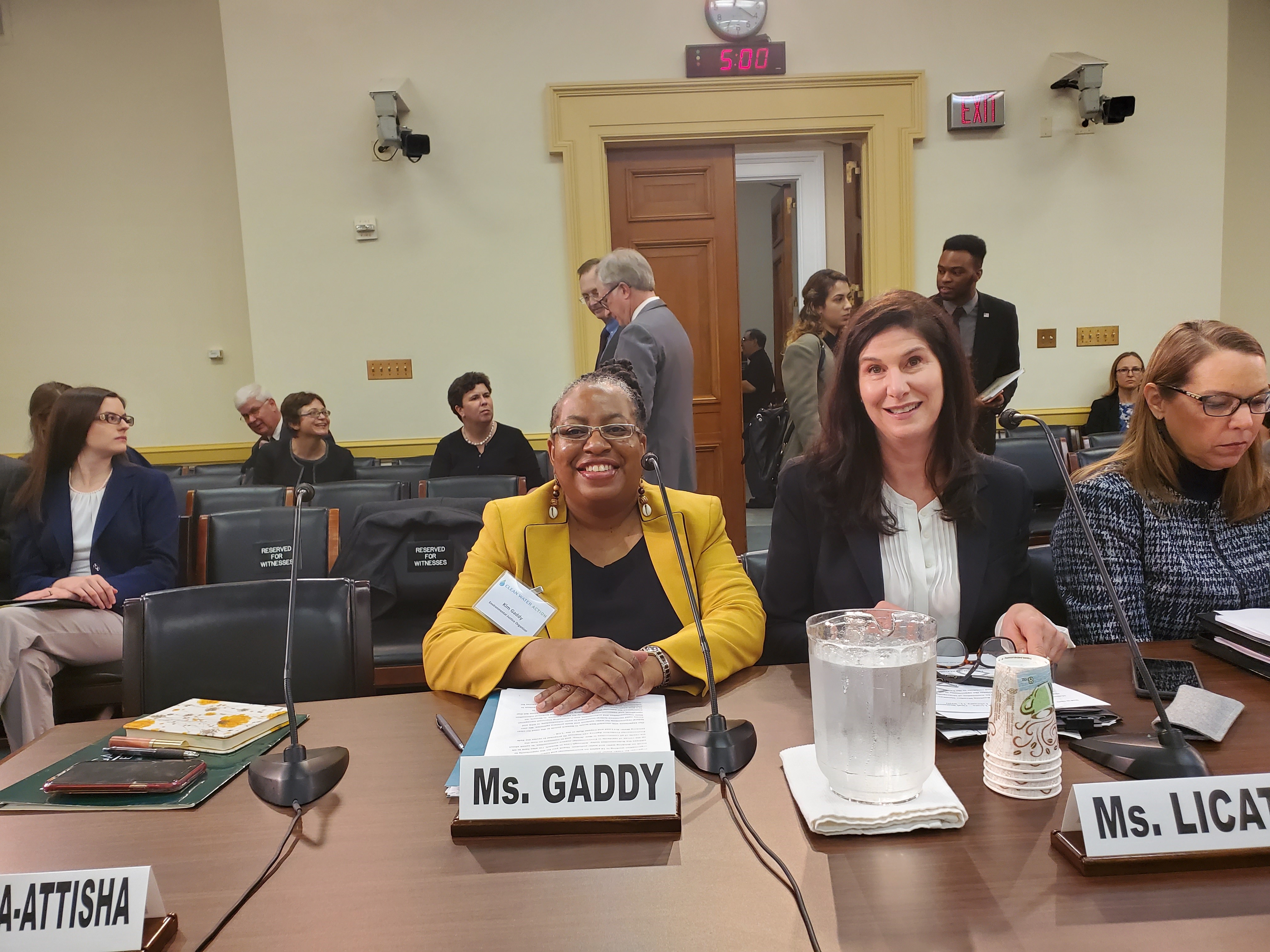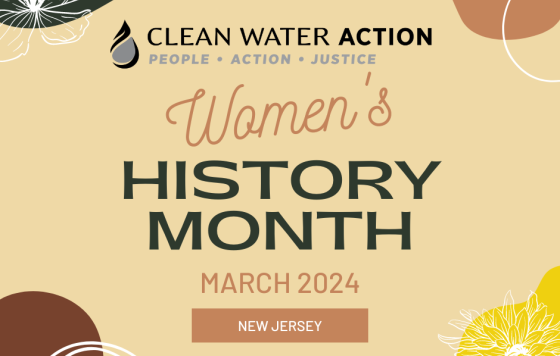
Today, I was honored to testify at the House Committee on Energy and Commerce Subcommittee on Environment and Climate Change Hearing on EPA's Lead and Copper Rule Proposal: Failing to Protect Public Health.
The U.S. Environmental Protection Agency (EPA) is failing to protect our communities from lead in our drinking water and its proposed updates to the Lead and Copper Rule (LCR) could be improved. Read my testimony below, watch it here, or download a copy here. Tomorrow is the last day to submit comments on EPA's Lead and Copper Rule Revisions - take action here!
"Good morning. My name is Deborah Kim Gaddy. I am the Environmental Justice Organizer for Clean Water Action in New Jersey. Clean Water Action is a national organization working in 14 states. Founded in 1972 to help pass and then engage the public in effective implementation of the Clean Water Act, Clean Water Action works on a wide array of environmental and health issues with a focus on drinking water and water pollution. Thank you for the opportunity to address the Subcommittee today. Although I live in Newark, I'm also here to lift up the voices of residents in Environmental Justice communities, to speak about the needs of all communities in New Jersey, and to comment on how the Environmental Protection Agency (EPA) can improve its proposal to revise the Safe Drinking Water Act Lead and Copper Rule (LCR).
Our experience with elevated lead levels in Newark points to the need for clear federal requirements for water systems and State primacy agencies. We also sorely need increased federal investment in water infrastructure, in EPA and State implementation and enforcement activities, and in promoting improved managerial, operations, and communications capacity for water systems. During the period where Newark experienced on-going exceedances of the LCR Lead Action Level, we experienced the difficulty of communicating public health risk and technical information to the public. At a time when residents needed the clearest possible information, they felt that city officials were not being transparent. The role of our State agency in overseeing our water system’s compliance with regulations was not clear to residents. We came to understand that clear requirements for water systems and well-defined responsibilities for State agencies and EPA are critical. Coordination within communities, for example with local public health agencies, is also important.
The City of Newark has now taken significant steps to reduce the risk of lead at the tap including partnering with the State to fully replace, at no cost to the home or building owner, 18,000 lead service lines in 3 years. New treatment has been installed and is expected to reduce lead levels by the end of the year. Filters and replacement cartridges have been made available to impacted residents, as well as free water testing and blood testing for children under six years of age. We are relieved to see progress but we think this crisis could have been avoided and if we can prevent similar problems in other New Jersey communities and those around the country we must act now.
Revisions to the Lead and Copper rule are not the only solution but they can help to prevent communities from experiencing what we have gone through in Newark. Updating these regulations to prevent lead at the tap is overdue. While water chemistry and treatment play a role in whether lead leaches from pipes and fixtures, removing sources of lead in contact with water is the best way to reduce lead at the tap. Lead service lines- the pipes that deliver water from the large water main to the home or building - are the largest source of lead in tap water.1 In its proposal, EPA missed an opportunity to address this source of lead by requiring full lead service line replacement at all regulated water systems. This is an ambitious undertaking but momentum toward full replacement has never been greater. Water systems across the country are prioritizing replacement and some have committed to fully replacing all lead service lines, including Newark. States are taking action to support this activity, including New Jersey.
EPA’s own proposal signals throughout that full lead service line replacement is a desirable goal that is achievable. EPA proposes that within 3 years, water systems prepare lead service line replacement plans that include a wide range of details that would be involved in planning for full replacement, including a replacement rate developed in consultation with the State, plans for notifying customers, procedures for filter provision and post-replacement flushing, and a funding strategy. While EPA’s proposal envisions these plans being used in the event replacements are done in the event of elevated lead levels, they suggest that EPA has determined that all systems with lead service lines or service lines of unknown composition are able to develop such plans. Yet, EPA stops short of putting a requirement in place. In Strategies to Achieve Full Lead Service Line Replacement, an EPA document published to support the proposed LCR revisions, EPA notes that “LSLR programs can be structured in ways to overcome potential legal, financial, and practical challenges related to full LSLR.”2 The document offers solutions to critical replacement program issues around legal issues and financing. Many other aspects of the proposal indicate that EPA knows that full lead service line replacement is the most obvious way to reduce lead at the tap. Yet they stopped short of requiring full replacement at all water systems.
Clean Water Action is calling on EPA to require full lead service line replacements at all water systems with a baseline goal of ten years. Had such a requirement been in place, perhaps Newark could have been spared the crisis that erupted in the wake of Lead Action Level exceedances. We need to start now to get the lead out of contact with drinking water to prevent elevated lead levels and similar crises in other communities in New Jersey and across the country.
As we learned in Newark, full replacement programs are impeded when customers are required to pay for replacement of the portion of the line under private property, often referred to as the “customer side.” It is more equitable and efficient for water systems to cover this cost. When Newark’s lead service line replacement program started, the home or building owner was required to contribute $1,000 toward the cost of the full replacement. While less than the cost that home or building owners currently pay in other communities, this was a disincentive in our community. Now the water system covers the entire cost of the full replacement. Although, Newark Mayor Baraka and the Municipal Council were able to secure funding to fully replace the 18,000 lead service lines in Newark, this will not be the case for all the other communities in New Jersey where lead service lines are present. Congress can and should help by increasing federal investment to help Environmental Justice and all communities achieve these and other clean water goals. The “Moving Forward Framework” recently proposed by the House Committee on Energy and Commerce and other Committees includes $22.9 billion in “Transformative Drinking Water Investments” and we support this proposal to invest in much needed improvements.
My personal experience in Newark included living in a rental property where the lead service line was replaced. In Newark, over 75% of residents are renters, who do not receive water bills or information about replacement programs and other issues. I can say from personal experience that aspects of EPA’s proposed revisions that increase outreach to renters and actual consumers of the water in the home or building are critical.
EPA needs to provide guidance for water systems on how to effectively reach the people who are consuming the water but not paying the bill. EPA needs to ensure that all aspects of the complex Lead and Copper Rule are as clear as possible so water systems know exactly what is required. Clear requirements are also essential for implementation and enforcement by the State agencies responsible for overseeing compliance. An updated Lead and Copper Rule will require increased State agency activity to be effective and to help make sure ongoing elevated lead levels like we experienced in Newark do not happen in other communities and that problems are spotted before they become crises. We are encouraged that the transformative drinking water investments proposed in the Moving Forward Framework include increases in Public Water System Supervision grants for State primacy agencies implementing the Lead and Copper Rule and other Safe Drinking Water Act regulations.
In communities like Newark, people are exposed to lead from numerous sources. We know that there is no safe level of lead. We know that health impacts of lead are of particular concern for children under 6, but that lead affects all of us. We must make more and faster progress on addressing all sources of lead. Right now, we have an opportunity to do more to reduce exposures from lead in drinking water. That’s why we are urging EPA to strengthen its proposal and urging Congress to support a vision of modernized drinking water systems by making bold investments now.
1 National Primary Drinking Water Revisions: Proposed Lead and Copper Rule Revisions, Federal Register Vol. 84 No. 219, November 13, 2019, p. 61694; American Water Works Association (AWWA) Water Research Foundation (2008) ‘‘Contributions of Service Line and Plumbing Fixtures to Lead and Copper Rule Compliance Issues’’ (Sandvig et al., 2008) estimates that 50 percent–75 percent of lead in drinking water comes from lead service lines.
2 Strategies to Achieve Full Lead Service Line Replacement, October 2019, EPA 810-R-19-003, page 5



